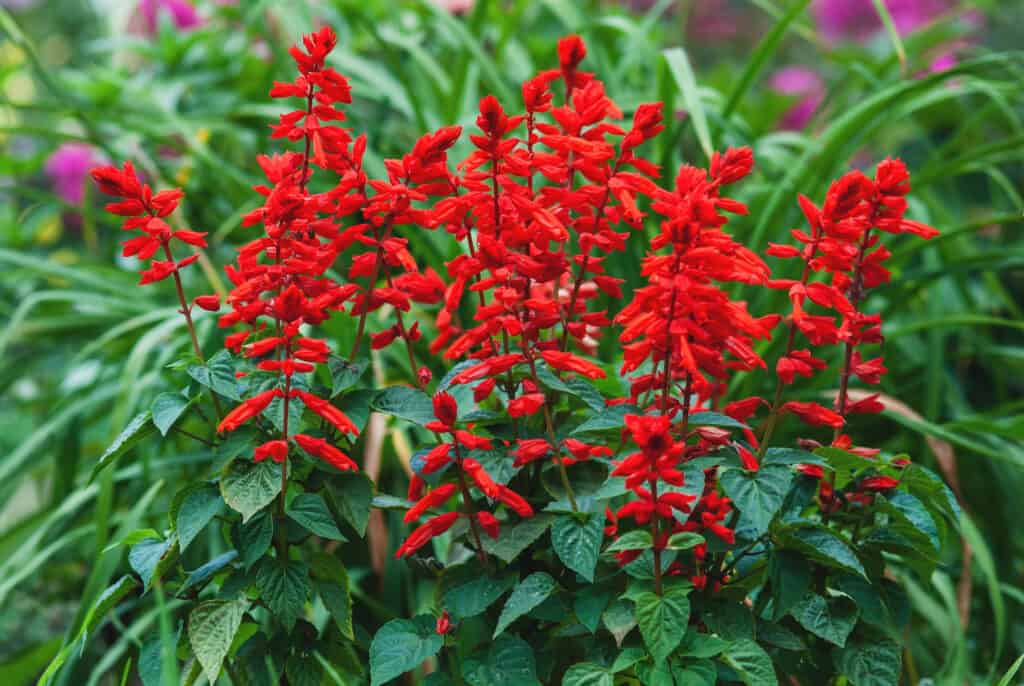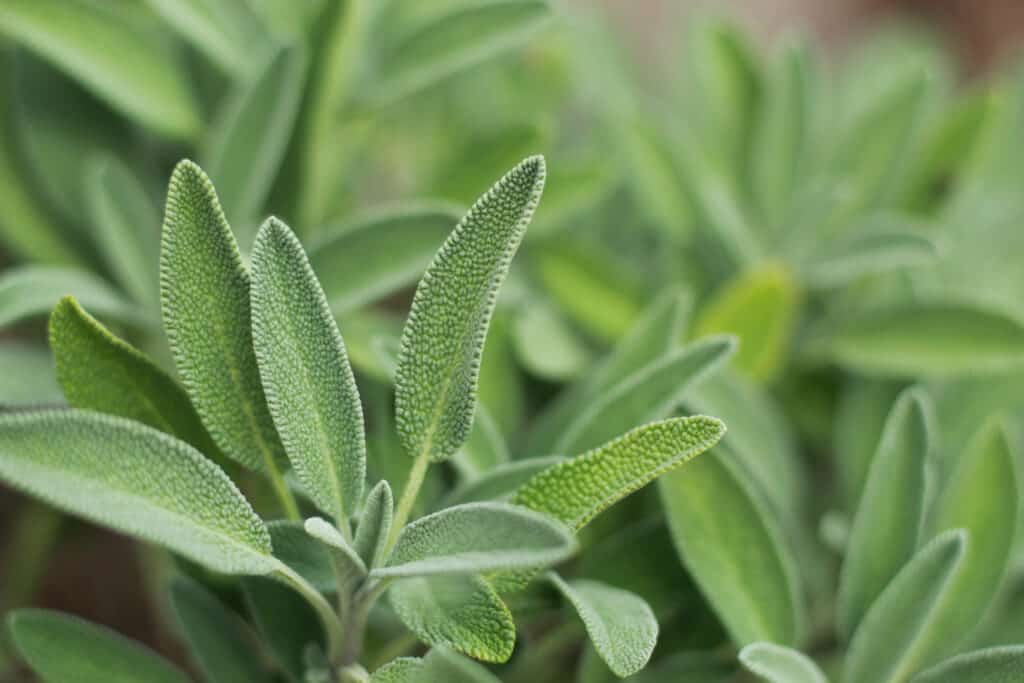Salvias are immensely popular plants with pollinator-friendly flower spikes and aromatic foliage that deters rabbits and deer from the garden, but is salvia a perennial or annual? The answer depends on your growing zone.
Salvia: Perennial or Annual?

Scarlet sage salvia produces vibrant red flowers that hummingbirds and butterflies enjoy.
©iStock.com/Nadya So
Salvia is an evergreen perennial not an annual. It will re-grow the following spring.
However, although salvias are perennials in their native environment, some species are not cold tolerant and killed by frost and snow. This leads some people to think they are annuals.
Most salvias are hardy, and therefore perennial from zones 5 to 9, and some of the toughest varieties like May Night Sage and Common Sage can survive zone 4. Outside these zones, salvia is treated as an annual.
What Exactly Is a Perennial?
A perennial is a plant that lives for two or more years. The majority of perennials are long-lived and not quite as showy as their annual cousins. A perennial may die back during winter and fool you into thinking it’s annual, but if it re-grows in spring, that’s a perennial!
Salvia is naturally a perennial, not an annual.
Annual Plants
Annuals complete their lifecycle in one year, from germination to setting seed and then dying off. They are commonly used as bedding plants and are easily grown from seed each year.
Biennial Plants
Another group of plants are biennials. They take two years to complete their lifecycle, rather than the urban myth of flowering twice a year.
Biennials germinate and develop foliage in year one, then flower, seed, and die in year two. Most gardeners plant biennial seeds in late summer, overwinter them, then plant them out once all frosts have passed to bloom for summer.
All About Salivas

Culinary sage is an aromatic herb that is part of the Salvia family.
©iStock.com/Bonnie McCann
Salvias are part of the Lamiaceae family of sages. It’s a huge genus that includes almost 1000 species and botanist still debate what plant belongs where! Lamiaceae is part of the menthae tribe that includes mint. You might be surprised to know it includes common sage and rosemary too!
Saliva is Latin for sage. The word is derived from salvus, which means safe and healthy (think salvation or a salve). Although it’s a sage, ornamental salvias are generally just called salvias. The name sage is saved for culinary sage.
Salvias are native to the Americas, Europe, Asia, and the Mediterranean. The majority of species are native to the Americas, particularly Central America and South America. The genus includes annuals, perennials, and woody shrubs, but it’s the 12 inch to 5 feet tall woody shrubs that gardeners are usually referring to when they speak about salvias.
Ornamental salvias have pollinator-magnet brightly colored flower bracts and aromatic foliage that produces oil when it’s rubbed. It’s one of the mechanisms plants use to defend themselves. Other than pollinators, animals are not fond of scented salvia foliage for breakfast! If you’re plagued by deer and rabbits, salvias are great deterrent plants.
Because salvias readily cross-pollinate in the wild (and in cultivation), there are many colors available from purple, red, orange, pink, and viole, to a mix of all these colors. The cultivar Hot Lips with its red and white flowers is particularly popular, along with Amistad, a rich purple beauty.
Which Salvia Is An Annual?
Most perennial salvias become annuals in zone 5 and under. For example, the popular Rockin’ Range and bright red Texan sage are not cold hardy, and will only survive a winter in zones 9-11.
Do Salivas Come Back After Winter?
Salvias are not tolerant of cold temperatures and rain, so there are very few that can make it through a winter in zone 5 and below. In warm zones, salvias come back after winter but this sun-loving plant may need some help. See below for more on that!
How To Winterize Salvias
Unless you’re in zone 9 and above, there’s a good chance your salvia won’t make it through the winter outside in the elements, but there’s no harm in trying!
First things first. If you have containerized salvia, they need to go into the ground. Soil is much better at protecting roots than containers are. Choose a sheltered spot that drains well, but if that’s not possible, it needs to go into a greenhouse or somewhere warm and frost free.
Trim back the salvias to 4-8 inches tall and surround them with a thick layer of protective mulch. You could try a cloche too.
Generally speaking, it’s best to winterize salvia by digging them up and bringing them indoors. Zones 9-11 and tropical-climate salvia growers can watch their salvias grow all year round!
Do Salvias Spread?
Salvias spread by seed, not by their roots. Each year perennial salvias grow bigger and take up more space. The ornamental varieties can reach five feet in height and spread. Be sure to give them enough room to grow.
Do You Deadhead Salvias?
Yes, deadheading salvias encourages more blooms. At the end of the growing season, you could leave some of the flowerheads to seed because birds enjoy them!
Salvias like full sun, but lighter colored flowers can cope with part shade. The more sun you can give them, the more flowers will bloom as a result.
Are Salvias Poisonous To Cats And Dogs?
The ASPCA don’t list salvia as toxic to pets, but it’s never a good idea to let pets eat large amounts of garden plants.
Salvia is Annual In Cold Zones
Ornamental salvias are perennial in their native sunny, frost-free environments, but in cold areas they are best grown as annuals.
To save money, try taking salvia cuttings. This is best done with new season growth. Choose a non-flowering stem and cut it just below a node. Strip the lower half free of foliage, and slide it into a pot of gritty compost.
Once all the cuttings are in place, place a clear freezer bag over the top. This traps humidity and helps the cuttings put out new roots. When you see new growth (it can be weeks, so be patient!) remove the plastic bag. Don’t forget to keep the soil moist, but not soggy.
So, there we have beautiful salvias and how to grow them. Figuring out whether salvias are perennial or annual isn’t always simple, so it’s best to check your growing zone and go from there.
Up Next:
- Is Sage A Perennial Or Annual?
- 8 Extinct Plants
- Aphids on Your Plants? How to Get Rid of Aphids Permanently
The photo featured at the top of this post is © TuiPhotoEngineer/Shutterstock.com
Sources
- USDA, Available here: https://planthardiness.ars.usda.gov/
- The Royal Horticultural Society, Available here: https://www.rhs.org.uk/plants/208839/salvia-hot-lips-/details
- Royal Botanic Gardens, Kew, Available here: https://powo.science.kew.org/
Thank you for reading! Have some feedback for us? Contact the AZ Animals editorial team.






